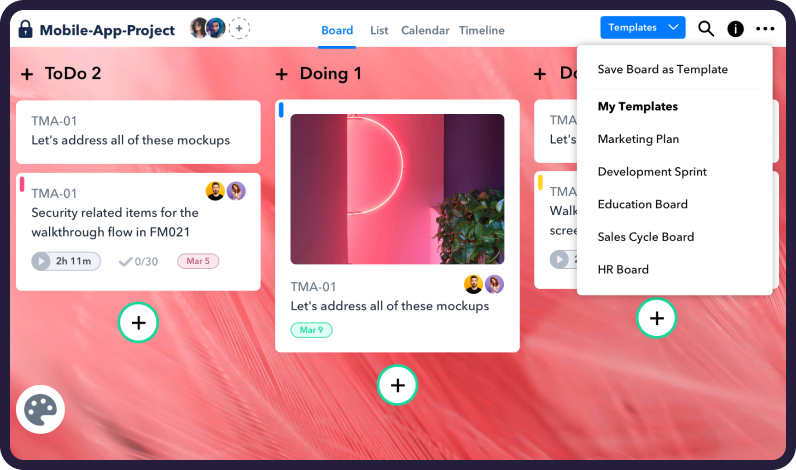Most managers believe that projects fail due to a lack of planning. This encourages them to add more layers to the planning process. But this only makes the process more complex. The truth is that projects fail due to a lack of transparency. That’s why seamless collaboration is key to project management.
If a lack of clear and consistent communication was a problem earlier, remote and hybrid work has only made it more challenging. Teams don’t have the relevant information and managers find it difficult to monitor and manage. In this blog, we share the most important aspects of managing a project as well as how to implement these ideas into your virtual team’s next project.
Define your scope
The first step in project management is to define the scope of the task. This has to be a specific agenda that doesn’t leave room for any confusion. Some managers might feel that the outline for the project should be fluid since it can change but that will create challenges later. Scope management includes identifying the following:
- Project goals
- Features
- Benefits
- Functions
- Deliverables
- Tasks
- Costs
- Deadlines
- Resources
The scope of the project should be summed up in a statement that clearly defines what the team is expected to deliver and should include all factors that might influence it. This document will help minimize disruptions and help the team stay on budget.
The scope statement should also explain why the organization needs the project and how its success will be evaluated. It should point out the technology or resources the team would need and any challenges they might run into.
Organize the team
Project management is another phrase for people management. For any project to be successful and within the given time, you need the right team members. You can choose them according to their domain expertise and the value you expect them to bring to the task.
While selecting members, leaders should outline their roles and responsibilities. Each individual should have a well-defined idea about what’s expected of them and the resources at their disposal. They should also know the reporting structure and other avenues of collaboration.
It’s important to be granular about the tasks by breaking them down into the smallest possible components. This makes it easy for the team to adhere to the plan. Broad expectations or responsibilities would leave room for error.
Establish your timeline
 Once you have your team and tasks defined, it’s time to set deadlines and timelines to deliver the final product. An effective strategy when setting timeframes is to set the final deadline and then work backward from there.
Once you have your team and tasks defined, it’s time to set deadlines and timelines to deliver the final product. An effective strategy when setting timeframes is to set the final deadline and then work backward from there.
In virtual project management, establishing a timeline and getting buy-in from all team members is of the utmost importance because, without physical interactions and onsite meetings, there could be confusion. That’s why you need a smart project management collaboration tool for remotely placed team members to track the progress of the project and communicate with managers.
Your timeline should have several micro milestones. These will help reveal problems and challenges. You will also know early on whether the members need additional resources. If people can’t get help on time, they may be disincentivized to perform at their best.
Use a project management tracking tool like HeyCollab
 Now that you have all of the information you need to get started, how will you track and manage everything? It’s best to place all this information into a project management tool like heyCollab, a platform designed for project management tracking in remote and hybrid workplaces.
Now that you have all of the information you need to get started, how will you track and manage everything? It’s best to place all this information into a project management tool like heyCollab, a platform designed for project management tracking in remote and hybrid workplaces.
What you need is an all-in-one project management platform designed for teams, founders, and freelancers. heyCollab makes it easy to plan projects, assign tasks, manage resources, and hold one-on-one chats. And unlike any other project management tracking tool, you get unlimited file storage.
This advanced and remote-friendly team project management allows you to easily input information. It gives you powerful visibility to track projects, assign owners, organize with labels, set due dates, and track your team. With the timeline view and calendar, you can easily keep track and ensure that the project stays true to the timeframe.
Have daily and weekly check-ins on key items
Regularly checking whether you’re honoring the timeline will help you meet the final deadline. You can schedule your check-ins based on the complexity of the project and the size of your team but it’s good to have both daily and weekly check-ins.
These check-ins will not only help with resource allocation but also take the pressure off your team members since they don’t have to wait for one big project assessment meeting. Remember that it’s best to implement minor changes regularly rather than redo the whole thing at a later stage.
You should also communicate your meeting expectations with your team. heyCollab is designed for one-on-one conversations for seamless collaboration. As a team leader, you will get quick visibility on project statuses and know if someone is overloaded with work or if someone can handle more.
Allow for adaptability and agility, plan for change
It’s inevitable with any project that there will be challenges and hiccups. Unexpected changes to the timeframe could be due to events within the organization or outside of it. Be sure to plan for this ahead of time. This may look like placing a couple of extra days in your timeline or having an alternate plan for certain deliverables.
In some cases, you might need additional budget or resources. This is another reason to have a scope statement since that would make it easy for you to get approval from the concerned departments or leaders.
You can look at the previous projects in your business to get a realistic timeframe. In case your organization has never done anything on this scale, it’s a good idea to look at projects in your industry or get information from other managers who may have experience on similar projects.
Have a close-out plan
![]() Once your project is finalized and completed, it’s great to have a plan in place to wrap everything up. This could be something like a peer review on performance, a promotion strategy around the deliverable, or a documented plan on how the product will be used.
Once your project is finalized and completed, it’s great to have a plan in place to wrap everything up. This could be something like a peer review on performance, a promotion strategy around the deliverable, or a documented plan on how the product will be used.
It’s not only necessary to have a close-out plan but it’s important to communicate that to the team members. This helps them place their project on a larger framework. It would also incentivize them to put in their best.
A peer review will give an objective view of team members’ contributions. A close-out plan also allows you to learn the best practices from the project that you can implement on other projects.
In short
With these remote team project management tips and with the help of an advanced virtual project management tool, project planning should be easy for your organization and your teams. Once you institutionalize these ideas and make them a standard part of your project planning, you will reap benefits for a long time.


